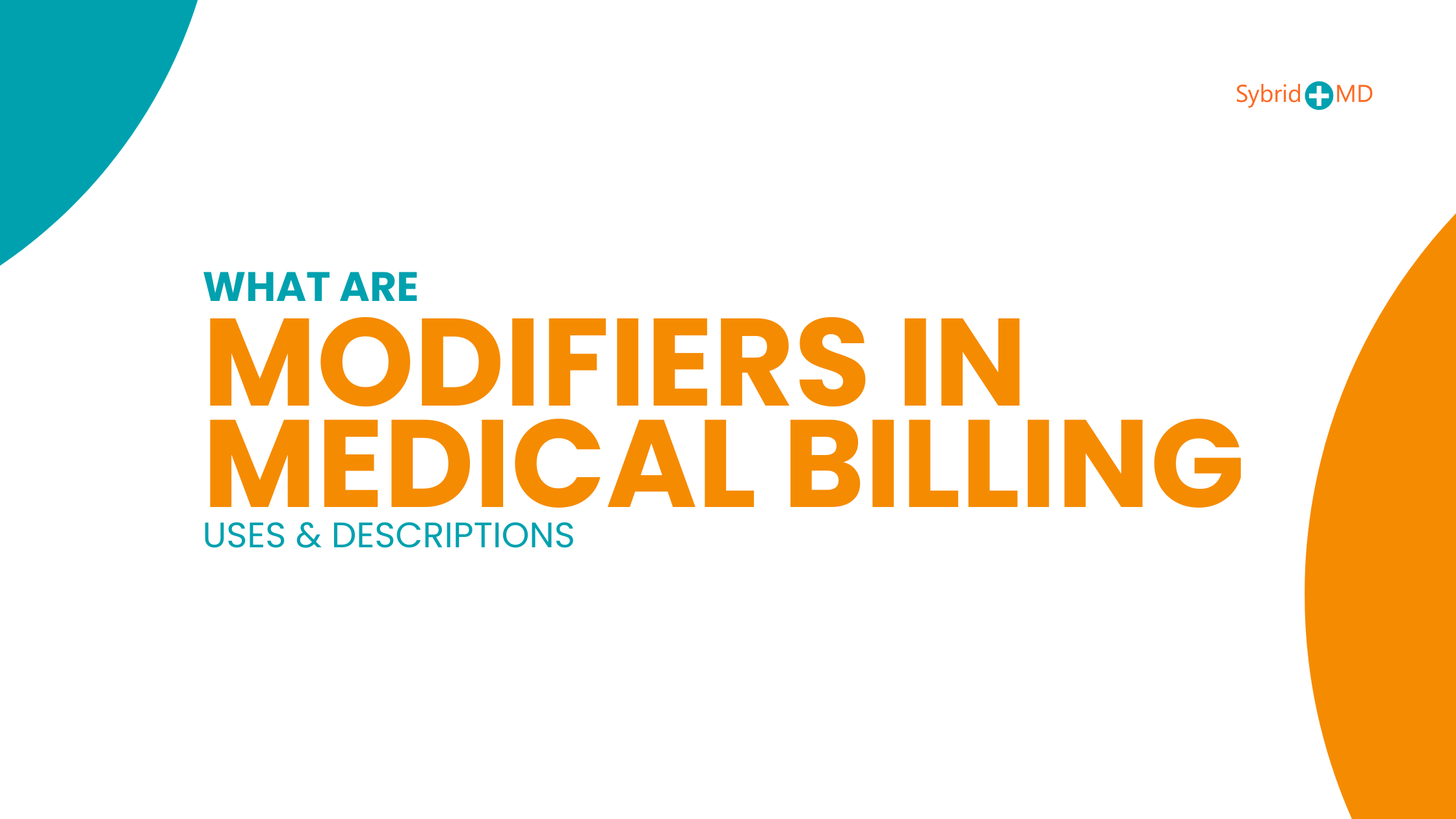Do you know that you can get into serious trouble if you use incorrect modifiers in medical billing? Even worse, if you have used the wrong modifier and the insurance company or payor had paid you for the service attached with a modifier, you have to return their money. In short, it can be a costly mistake when claims are made on the wrong modifiers. As a provider, you must know what is a modifier in medical billing, when to use and when not to use modifiers to modify the reimbursements or maximize the payments in order to avoid claim denials.
Here are some common modifiers, and red flags that you should constantly watch for in the medical billing process.
What is modifier in medical billing with example

source:verywellhealth.com
Modifiers are used to give a concise view of the medical billing demonstrating the type of services and procedures provided by the physician or healthcare organization. These codes are added to Current Procedural Terminology (CPT) or Healthcare Common Procedure Coding System (HCPCS) for a similar purpose.
It becomes more complex to understand the right use of modifiers when insurance companies or third-paying parties make their own rules of how these modifiers are used while doing HCPCS or CPT billing. It is also important to understand that it is not specifically correct to use all modifiers along with CPT or HCPCS codes while medical billing.
The federal government and Healthcare organizations keep changing the rules for medical coding and billing. Therefore, it is also necessary to keep yourself updated with the Local Coverage Determination (LCD), Medicare Administrative Contractors (MAC), and National Coverage Determinations (NCD) to claim and code your bills correctly.
Examples of modifiers in medical coding
Example 1: The surgical treatment of the wrist (CPT code 25607) includes performing a carpal tunnel release (CPT code 64721) at the same time. The application of modifier 51 shows that the secondary procedure took place at the same time as the primary procedure.
Example 2: A patient received a knee injection (20610) and a shoulder injection (20670) on the same day, which allowed the use of modifier 59.
Advantages of Using Modifiers
- Medical billing professionals should aim to prevent claim rejections by ensuring the submission of precise and error-free claims.
- By submitting claims with precise coding details, healthcare billing professionals can secure appropriate reimbursements.
- Medical providers can receive better reimbursements for performed services through the use of modifiers that describe how services were delivered outside of standard procedures.
Misuse of Modifiers
Many times, providers remain unaware of the new updates in the coding and billing systems and here they make mistakes and add wrong modifiers. Hence, it is necessary to avoid using wrong modifiers because they can bring serious consequences for the modifiers and might lead to a critical audit.
Unfortunately, the audit performed due to the wrong modifier use can lead to hefty legal ramifications along with heavy fines. The audit is not necessarily finished after a conviction but can last for years. If the misuse of modifiers were found in Medicare billing, fines can go up to $10,000 for every wrong entry. This means whenever you use a wrong modifier in your claim, you’ll have the legal obligation to pay $10,000 for every occurrence. And believe us, that adds up rapidly.
What are HCPCS and CPT Codes in medical billing?
HCPCS are alpha-numeric five-character code sets that are used to bill Medicaid and Medicare patients. These codes are used for the patients who receive the services of a physician, procedures, and the equipment for their health conditions that are covered by the CPT codes.
CPT codes, however, are five-character codes of four types designed and issued by the American Medical Association. For these codes, two-character modifiers are used to elaborate any type of procedure the patient has received from the assigned doctor. These CPT codes are both numeric and alphanumeric.

source:icd10monitor.com
Advantages of adding modifiers
Unless modifiers are used correctly, they cannot help you gain anything but may cost everything. The correct use of modifiers aid in;
- Minimizing the claim denial rate and making your claims clean and accurate
- Claims are submitted more precisely with a significantly higher level of coding. So, the high and quick reimbursements can be expected
- Claims are approved in a timely manner without creating a revenue gap due to denials, resubmitting, and follow-ups. Physicians are compensated for the services they rendered no matter the nature of the case. These codes specify the exact equipment, service, or procedure the patient has taken.
Common Types of Modifiers
- Level I Modifiers: CPT modifiers are also called Level I modifiers and are managed and updated by the American Medical Association (AMA) annually.
- Level II Modifiers: HCPCS of Level II Modifiers are a combination of numbers and alphabets. These modifiers are regulated by the Center for Medicare and Medicaid Services (CMS).
Common Modifiers in the Medical Billing codes

source:physicianpractice.com
- GQ – GQ modifier is used for the services rendered over an asynchronous telecommunication system. It is the system where a physician gathers the medical history of a patient, pathology reports, and images and sends them over to a senior medical practitioner to review and have their opinion on the treatment and diagnosis.
- 95 or GT – Modifier 95 or GT can be used when all the evaluation treatments and diagnoses are meant to be coded via telemedicine. This modifier can only be applied when the treatment and medicines were given only over a telecommunication system either via phone or video commutation. When there’s an insurance payer, code 95 would be written as GT.
- GO– GO modifier is used to code the acute stroke telehealth services offered.
- Modifier 24 – The code is used to append the unmatched management and evaluation services offered after the procedures of major surgeries. These codes must be applied if the post-procedure services are rendered over 90 days of period by the same surgeon. However, the modifier cannot be used to bill for these services.
- Modifier 25 – It is commonly used by pediatrics. It is used to connect all the evaluations and management performed by the same surgeon on the same day.
- Modifier 26– Modifier 26 is used to bill the services performed by both physicians and technicians. It is to understand that this modifier can also be used for technical services such as radiology. Note that the scan performed by the physician or technician will be considered the professional service offered and the machinery would be considered the technical component used in the service.
- Modifier 27 – This modifier can be used for a variety of reasons. This includes when the patient is offered multiple evaluation and management services from the same or different surgeons, used clinical service, pharmacy, and primary care on the same day.
- Modifier 51– Modifier 51 is used to bill for multiple services and procedures offered to the patient by the same provider but in a single procedural setting or surgical session.
List of modifiers in Medical Billing
Types of Modifiers in Medical Billing
The classification of modifiers can be divided according to coding systems such as the Healthcare Common Procedure Coding System (HCPCS) and Current Procedural Terminology (CPT). Modifiers exist beyond just the HCPCS and CPT categories. This section provides an in-depth examination of the various types of modifiers.
1. CPT Modifiers
CPT modifiers typically consist of two digits, and the American Medical Association (AMA) maintains ownership rights. Alphanumeric performance-measure CPT modifiers apply solely to category II codes and provide extra details about healthcare services reported through the CPT coding system.
CPT 25: The same physician or other healthcare professional offers a significant evaluation and management service that is distinct from the procedure provided on the same day.
2. HCPCS Level II Modifiers
HCPCS modifiers consist of two characters, one letter followed by one digit. The HCPCS coding system is managed by the Centers for Medicare and Medicaid Services (CMS). Modifiers can be paired with HCPCS level II codes to deliver extra information regarding medical procedures performed.
Examples of HCPCS Level II modifiers include:
- E1: Upper left, eyelid
- TC: A separate charge can be billed for the technical component of certain procedures like X-rays provided by portable X-ray suppliers under specific conditions.
- XS: The XS modifier indicates separate structure services which are performed on distinct anatomical structures like organs.
3. NCCI Modifiers
Medicare and Medicaid allow these modifiers to bypass the National Correct Coding Initiative (NCCI) Procedure-to-Procedure (PTP) edits under specific clinical conditions. The action of circumventing the edit process receives the designation of unbundling. The NCCI modifier 59 stands for distinct procedure.
4. Pricing Modifiers
Pricing modifiers in medical billing live up to their name by altering the payment amount for the services billed under their code. Medicare operates through a Multi-Carrier System (MCS) which mandates medical coders to insert a pricing modifier ahead of any informational modifier. The CMS 1500 claim form requires the placement of the 24D modifier directly beside the procedure code. Payment delays and denials can occur when you neglect to place the pricing modifier in its correct position.
5. Informational Modifiers
The proper placement of an informational or statistical modifier on a medical claim occurs after the pricing modifier. The informational modifier functions independently from payment modifiers yet influences reimbursement amounts. Coders use modifier 59 to bypass NCCI PTP edits, allowing them to bill for both procedures. Here, 59 is an informational modifier
How to use modifiers in medical billing
Medical billing modifiers consist of two-character codes that can be numeric, alphanumeric, or alphabetic and offer extra information about medical procedures and services. Modifiers serve to explain conditions that can affect reimbursement payments.
Steps to Use Modifiers Correctly
- Determine if a Modifier is Required: Apply a modifier when the service or procedure deviates from standard billing guidelines, such as multiple providers or special circumstances.
- Choose the Correct Modifier: A doctor must use Modifier 25 (Significant, separately identifiable E/M service) when they perform an E/M service on the same day they conduct a minor procedure.
- Attach the Modifier to the CPT Code: The claim form requires placing modifiers immediately after the CPT code (such as 99213-25). If multiple modifiers apply, list them in the correct order. When multiple modifiers are applicable, they should be listed in this order: functional modifiers that influence payment first, followed by informational modifiers.
- Ensure Proper Documentation: Documentation within medical records needs to validate the application of the modifier. Insufficient documentation can result in insurance companies denying claims.
- Verify Payer-Specific Guidelines: Medicare, Medicaid, and private insurance companies enforce their own unique modifier policies.
List of modifiers in medical billing with description
Private insurance plans and Medicare as insurance payers can reject claims when code modifiers are not present or when they are applied incorrectly. Medical billing specialists need to work closely with healthcare providers to remain informed and prevent revenue loss. Here is the list of list of common modifiers in medical billing.
1. Modifier 22: Additional Procedural Work
Apply this code modifier when the procedure exceeds its normal level of difficulty and effort, which requires further procedural work. The use of Modifier 22 allows healthcare providers to explain the need for higher reimbursement rates from insurance companies based on the procedure requiring more skill and time due to its complex nature. When submitting claims with Modifier 22, you must attach supporting documentation to validate its use and secure timely reimbursements.
2. Modifier 25: Separately Identifiable E/M Service
The modifier code Modifier 25 serves as a standard tool in medical billing which shows that the physician provided a separate distinct evaluation and management service to the same patient on the same day. You can receive reimbursement for both the E/M service and the procedure when the former service remains both significant and separately identifiable. Modifier 25 shows that the delivered E/M service extended beyond regular post-operative and pre-operative care linked to the procedure.
3. Modifier 26: Technical Component (TC)
Modifier 26 communicates that the physician delivered only the professional aspect of the service while another party supplied the technical component. The payer will provide compensation only for the professional component when this modifier is applied. An example of this situation occurs when a physician analyzes lab test results without conducting the actual lab tests.
4. Modifier 33: Preventive Care
You can use Modifier 33 whenever a patient encounter focuses on preventive care instead of therapeutic or diagnostic services. This modifier makes sure that preventive care services receive separate reimbursement from the payer.
5. Modifier 47: Anesthesia by Surgeon
The surgeon may indicate that they provided regional or general anesthesia by adding the modifier ’47’ to the surgical code.’47’ to the surgery code. (This does not include local anesthesia.)
6. Modifier 50: Bilateral Procedure
For medical claims involving procedures performed on both sides of the patient’s body during a single encounter, use Modifier 50 to document bilaterality. The payer compensates the provider properly based on the extra resources and complexity involved.
7. Modifier 51: Multiple Procedures
When a single provider performs multiple surgeries or procedures and diagnostic imaging services during one surgical session, this modifier applies.
8. Modifier 59: Distinct Procedures
Modifier code 59 helps denote care services or procedures that stand alone from other treatments provided on the same day. This modifier ensures payers understand the procedure occurred at a different anatomical site, which helps avoid service bundling claims denials.
9. Modifier 62
Modifier 62 indicates that two surgeons operated together as co-surgeons where each surgeon performed different portions of the same procedure. The same CPT code must be reported by both surgeons when using Modifier 62 and the reimbursement is typically divided equally between them. The medical records must demonstrate why two surgeons performed the procedure together.
10. 63 Procedure Performed on Infants
Healthcare providers apply this modifier code to procedures performed on neonates or infants who weigh less than 4 kilograms. The heightened complexity and risk of some procedures may lead to increased reimbursement payments. Certain CPT codes, including neonatal critical care services, do not allow the use of this modifier.
11. Modifier 76
It indicates when a physician repeats the same procedure or service on the same patient during one calendar day. This code shows that the same doctor performed the procedure or service multiple times within one day.
Example: The physician carries out a wound debridement procedure on the patient using CPT code 11042. Due to further complications another wound debridement procedure is carried out later on the same day. A physician applying Modifier 76 to the second debridement code shows that the procedure is a repeat of the initial procedure performed by them on the same day.
Conclusion
Medical billing professionals must understand commonly used modifiers because they ensure accurate reimbursement and prevent claim denials. Healthcare providers can achieve fair reimbursement for their services and reduce claim rejections through the proper use of modifiers. Modifiers deliver essential details about medical claims which leads to substantial effects on reimbursement outcomes. Choosing the appropriate modifier proves difficult when numerous modifiers share similar descriptions.
Modifiers receive updates to reflect medical practice changes along with modifications in coding rules and payer requirements. Working with expert medical billing and coding services serves as an effective approach to correctly apply modifiers and stay informed about updates while reducing costly errors and maximizing reimbursement potential. The proper application of modifiers demands strict compliance with coding rules and documentation requirements established by insurance companies. Medical coders and billing professionals must regularly update their knowledge of current coding rules and regulations to maintain compliance.
FAQs:
Why are modifiers important in medical billing?
Modifiers serve an essential function in medical billing as they supply supplementary details about medical services. It enables accurate representation of patient care and ensures correct insurance reimbursement by detailing elements that primary procedure codes miss while maintaining the procedure code’s fundamental definition.
What are modifiers in medical billing?
Medical coding modifiers consist of two characters which can be either letters or numbers and they attach to either a CPT® code or a HCPCS Level II code. The modifier adds extra details to describe the medical procedure, service, or supply while keeping the meaning of the code unchanged.
How do I know which modifier to use?
Selecting the proper modifier requires an examination of procedure details, which encompass location specifics, provider involvement, and any special circumstances. Review payer guidelines from Medicare, Medicaid, and private insurers because their rules differ. Documentation must validate the modifier to prevent claims from being denied. Coding resources, including CPT manuals and HCPCS manuals, along with payer policies, provide necessary accuracy.
What are some common modifiers used in medical billing?
Common modifiers in medical billing include:
- Modifier 25 represents a significant Evaluation and Management service that is separately identifiable and performed on the same day as another procedure.
- Modifier 59 serves as a distinct procedural service marker to avoid bundling edits in medical billing.
- Modifier 50 indicates a medical procedure that was carried out on both sides of the patient’s body.
- Modifier 62 indicates when two surgeons share responsibility during a single surgical procedure.
- Modifier 76 indicates when a provider performs the same procedure more than once on the same day.
How do modifiers affect reimbursement rates?
Modifiers provide critical details about medical services that enable payers to evaluate the complexity of the care given which leads to proper reimbursement amounts for healthcare providers. Using accurate modifiers increases reimbursement rates when they represent complex situations that need extra pay while incorrect modifiers can cause reduced payments or complete claim rejection.

